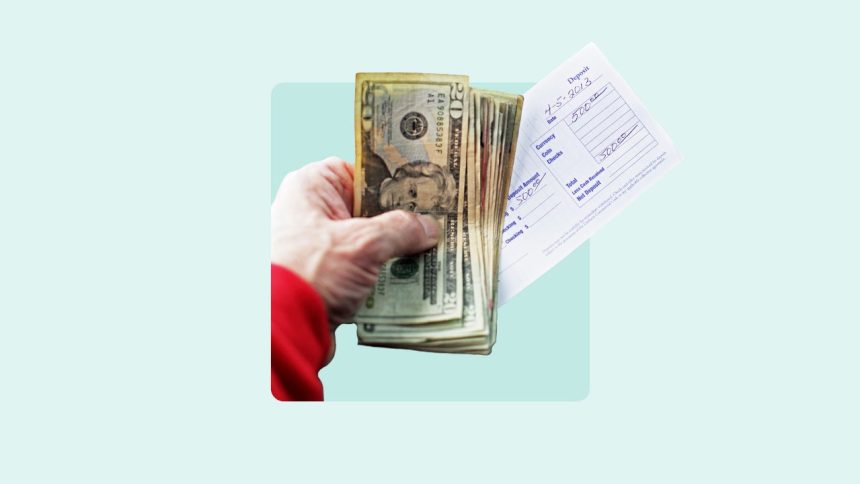Key takeaways
- You can deposit money into someone else’s bank account via electronic transfer, wire transfer, check or money order.
- Electronic transfers and wire transfers are generally faster and more convenient than traditional methods such as checks and money orders.
- Some banks restrict cash deposits into accounts that are not in your name to prevent money laundering and fraud.
- It pays to shop around for the most convenient and cost-effective ways to deposit money into another person’s account.
Depositing money into another person’s bank account is a convenient way to pay back a friend, send an allowance to a college student or give some birthday money to a relative.With the prevalence of digital banking and money transfer apps, sending funds to someone else’s bank account has become more convenient and can often be done without the need for cash.
Fortunately, there are several options for depositing money into someone else’s account, whether electronically or in person at a bank branch.
1. Make an electronic transfer
You can easily transfer money into a friend or relative’s account through a service such as Venmo, PayPal or Cash App. You can also move money to others through Zelle — and since most banks already include Zelle in their offerings, you won’t likely need to sign up for this service separately.
As a rule, exercise caution when making electronic transfers. When you send money to someone else through these kinds of services, the payments are often irrevocable. Don’t transfer money to anyone you don’t know and trust to avoid falling victim to a scam.
Another option is to make a direct transfer electronically from your bank account to that of your friend or family member. For this, you’ll need to provide the other person’s bank account number and routing number. Unlike Zelle and some other digital payment networks that move money in minutes, this kind of bank-to-bank transfer can take a few days.
2. Make a wire transfer
A wire transfer is another option for transmitting money to someone else’s bank account. Wire transfers can be done at banks, credit unions, or providers such as Western Union or Wise.
To conduct a wire transfer, you’ll usually need the account number, routing number and recipient’s name.
When sending a sizable amount of money, a wire transfer may be your best option, as those done through a bank commonly have no limits. Domestic wire transfers can also be conveniently quick, as they commonly take just a few hours to process.
Wire transfers can be expensive, however, compared to services like Zelle that don’t charge a fee. Fees for domestic outgoing wire transfers can cost as much as $40, while outgoing international ones tend to range from $35 to $75.
3. Write a check
Though paper checks are falling out of favor, you can still write and deposit a personal check into someone else’s bank account. For security reasons, banks may prefer checks to cash because they can trace the money with a check, unlike cash.
“The key question is always: ‘Where did you get that money?’” says Marc Trepanier, senior principal fraud consultant at ACI Worldwide, a software provider. “With a check, we know where it came from. It came from another account.”
A check can be deposited into another person’s account at a branch when you present it to the teller, along with the recipient’s name and account number.
A disadvantage of depositing a check is that, unlike cash, the bank sometimes doesn’t immediately make the funds available.
“The check can clear and settle in hours depending on the circumstances,” says Bob Meara, principal analyst at Celent, a financial-services research and consulting firm. “But most banks wait a business day for funds availability for most customers simply so they can see if the check clears.”
4. Deposit cash at the bank
You can put cash into someone else’s account by going to a bank where the person holds an account and giving the teller the person’s name and account number.
However, some banks don’t allow you to deposit cash into an account that’s not in your name. For instance, large brick-and-mortar bank Wells Fargo states in its deposit account agreement that non-account owners are not allowed to deposit cash into consumer accounts.
Prohibiting cash deposits can help prevent money laundering and fraud from a bank’s perspective. However, it’s also expensive for the bank to process cash.
Though you might feel inconvenienced, there are alternatives — some of which are quicker than depositing cash into someone else’s account at a branch.
5. Use a cashier’s check
Instead of writing a personal check, you can deposit a cashier’s check into someone else’s bank account. You pay the bank the money for a cashier’s check up front, and the bank generates the check for that amount and makes the check out to your intended recipient.
The benefit of a cashier’s check is that there is no risk of it bouncing since it’s backed by the issuing bank’s funds, and it usually clears more quickly than a personal check.
6. Use a money order
If you don’t want to use a personal or cashier’s check to deposit money into someone else’s account, using a money order is an alternative, old-school option.
You can obtain a money order at banks and credit unions, post offices, chain drug and grocery stores, and some big-box retailers. It’s relatively inexpensive to send a money order. For example, the U.S. Postal Service’s service fee is $2 for domestic orders of up to $500.
The money order comes with a receipt, and an upside of money orders is they can typically be replaced if they’re lost or stolen. You pay for a money order up front, like a cashier’s check, so there’s not any risk of them bouncing.
See what other banks offer
There are plenty of ways to deposit funds into the account of a friend or relative. Not every bank allows for all methods, so if your bank doesn’t offer the service you find easiest or need to use, it may pay to switch banks.
What’s more, a different bank may offer other perks, such as better rates on certificates of deposit (CDs), savings accounts and mortgages or even a more useful mobile app.
Bottom line
Electronic options such as Zelle, Venmo, and wire transfers, can make moving money into another person’s bank account quick and inexpensive. Old-school methods, such as depositing money in person at a bank branch, are still viable options, although they’re often less convenient than modern digital options.
–Freelance writer Allison Martin contributed to updating this article.
Read the full article here














